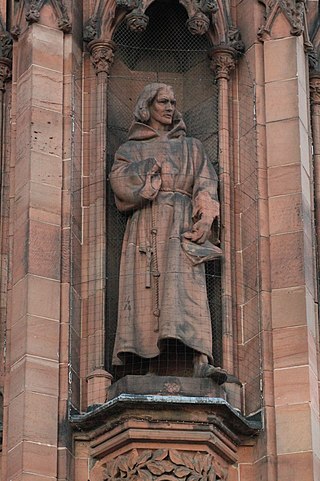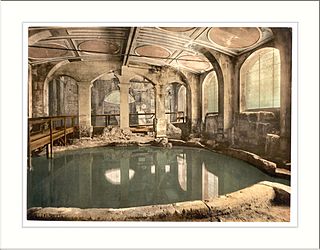Medieval poetry
Latin poetry
The theme was the common property of medieval Latin poets. The line of Boethius (5th century) was well known: [3]
Ubi nunc fidelis ossa Fabricii manent?
Where now do the bones of faithful Fabricius lie?
The words Ubi sunt begin several Latin medieval poems and occur, for example, in the second stanza of the 13th-century goliardic song "De Brevitate Vitae", known from its incipit as Gaudeamus Igitur:
Ubi sunt qui ante nos / In mundo fuere?
"Where are those who, before us, existed in the world?"
English poetry
Old English
A general feeling of ubi sunt radiates from the text of Beowulf . The Anglo-Saxons, at the point in their cultural evolution in which Beowulf was written, expressed in their poetry an inescapable feeling of doom, symptomatic of ubi sunt yearning. By conquering the Romanized Britons, they were faced with massive stone works and elaborate Celtic designs that seemed to come from a lost era of glory (called the "work of giants" in The Ruin).
Prominent ubi sunt Anglo-Saxon poems are The Wanderer , Deor , The Ruin , and The Seafarer (all part of a collection known as the Exeter Book, the largest surviving collection of Old English literature). [4]
The Wanderer most clearly exemplifies Ubi sunt poetry in its use of the erotema (the rhetorical question):
Hwær cwom mearg? Hwær cwom mago? Hwær cwom maþþumgyfa?
Hwær cwom symbla gesetu? Hwær sindon seledreamas?
[...] Hu seo þrag gewat,
genap under nihthelm, swa heo no wære. [5]Where is the horse gone? Where the rider? Where the giver of treasure?
Where are the seats at the feast? Where are the revels in the hall?
[...] How that time has passed away,
grown dark under cover of night, as if it had never been.
(tr. Robert Diamond) [6]
Middle English
The 13th-century poem "Ubi Sunt Qui Ante Nos Fuerunt" (Where are those who were before us?) is a Middle English example following the medieval tradition: [7]
Uuere beþ þey biforen vs weren,
Houndes ladden and hauekes beren
And hadden feld and wode?
Þe riche leuedies in hoere bour,
Þat wereden gold in hoere tressour
Wiþ hoere briȝtte rode; ... [8]
Which roughly translates to:
Where are those who were before us,
who led hounds and bore hawks,
And owned field and wood?
The rich ladies in their chambers,
Who wore gold in their hair,
With their bright faces; ...
French and Spanish poetry
The 13th-century French poet Rutebeuf wrote a poem called Poèmes de l'infortune ("Poems of the misfortune" – or bad luck) which contains those verses:
Que sont mes amis devenus
Que j'avais de si près tenus
Et tant aimés?What has become of my friends
That I had held so close
And loved so much?
In the second half of the 20th century, the singer Léo Ferré made this poem famous by adding music. The song was called Pauvre Rutebeuf (Poor Rutebeuf).

The medieval French poet François Villon (15th century) also famously echoes the sentiment in the Ballade des dames du temps jadis ("Ballad of the Ladies of Times Past") with his question:
Mais où sont les neiges d'antan?
Where are the snows of yesteryear?
This refrain was taken up in the bitter and ironic Bertolt Brecht/Kurt Weill "Nannas Lied", [9] expressing the short-term memory without regrets of a hard-bitten prostitute, in the following refrain:
Wo sind die Tränen von gestern abend?
Wo ist der Schnee vom vergangenen Jahr?Where are the tears of yesterday evening?
Where is the snow of yesteryear?
In "Coplas por la muerte de su padre", the 15th-century Spanish poet Jorge Manrique wrote equally famous stanzas about contemporaries that death had taken away:
¿Qué se fizo el rey don Juan?
Los infantes de Aragón
¿qué se ficieron?
¿Qué fue de tanto galán,
qué fue de tanta invención
como trujeron?
Las justas y los torneos,
paramentos, bordaduras
y cimeras,
¿fueron sino devaneos?
¿qué fueron sino verduras
de las eras?
What became of King Don Juan?
The Princes of Aragon,
What became of all of them?
What of so much handsome nobility?
And of all the many fads
They brought with them?
What of their jousts and tournaments,
Gilded ornaments, fancy embroideries
And feathered tops?'
Was all of that meaningless waste?
Was it all anything else but a summer's green
on the fields?
(tr. Simón Saad)
German poetry
The theme also occurs in the ninth-century Old High German poem Muspilli , which contains these lines (60-62):
uuar ist denne diu marha, dar man dar eo mit sinen magon piehc?
diu marha ist farprunnan, diu sela stet pidungan,
ni uueiz mit uuiu puaze: so uerit si za uuize."Where is then the land, where man once waged war on/with his kinsmen?
The land is burnt down, the soul stands subdued,
It knows not how to atone: thus it goes to damnation."
Persian poetry
In medieval Persian poetry, Ubi sunt? is a pervasive theme in The Rubaiyat of Omar Khayyam :
Each Morn a thousand Roses brings, you say:
Yes, but where leaves the Rose of Yesterday?
And this first Summer month that brings the Rose
Shall take Jamshýd and Kaikobád away.
(tr. Edward Fitzgerald)
Frequently in Khayyam there is a play on the sound of the word kū "where are they?", as in the following quatrain: [10] [11]
dar kaargah-e kuzegar-i raftam dush
didam do hazaar kuze guyaa vo khamush
naagaah yek-i kuze baraavard khorush:
kukuzegar o kuzekhar o kuzeforush?"In the workshop of a potter I went last night
I saw two thousand pots speaking and silent.
Suddenly one pot raised a cry:
Where are they, the potter, and the pot-buyer, and the pot-seller?"
And similarly in the following, where the mournful "coo-cooo-coo" [12] of the Eurasian collared dove is said to represent the sound of "Where are they? Where are they?" [13] [14]
aan qasr ke bar charkh hamizad pahlu
bar dargah-e u shahaan nehaadandi ru
didim ke bar kongere-ash faakhte-i
benshaste hamigoft ke kukukuku?"From that royal palace which once rose to the sky
monarchs in splendor faced the world.
But on its turrets I have seen a ring-dove seated,
cooing, cooing over and over: where, where?"
(tr. Michael Hillmann, Iranian Culture, 51)
Chinese poetry
The Former Ode on the Red Cliffs of Su Shi, written in 1082, makes heavy use of the theme, including the line: "Cao was indeed a hero for his generation but where is he now?"










